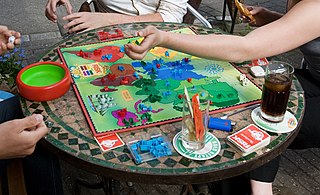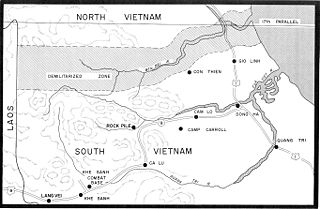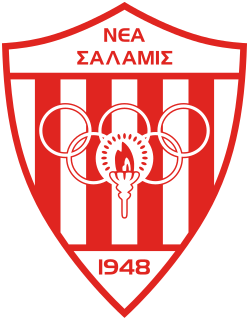
Risk is a strategy board game of diplomacy, conflict and conquest for two to six players. The standard version is played on a board depicting a political map of the world, divided into forty-two territories, which are grouped into six continents. Turns rotate among players who control armies of playing pieces with which they attempt to capture territories from other players, with results determined by dice rolls. Players may form and dissolve alliances during the course of the game. The goal of the game is to occupy every territory on the board and, in doing so, eliminate the other players. The game can be lengthy, requiring several hours to multiple days to finish. European versions are structured so that each player has a limited "secret mission" objective that shortens the game.

Civilization is a board game designed by Francis Tresham, published in the United Kingdom in 1980 by Hartland Trefoil, and in the US in 1981 by Avalon Hill. The Civilization brand is now owned by Hasbro. It was out of print for many years, before Gibsons Games republished it in 2018.

A demilitarized zone is an area in which treaties or agreements between nations, military powers or contending groups forbid military installations, activities or personnel. A DMZ often lies along an established frontier or boundary between two or more military powers or alliances. A DMZ may sometimes form a de facto international border, such as the 38th parallel between North and South Korea. Other examples of demilitarized zones are a 190-kilometre-wide (120 mi) area between Iraq and Kuwait, Antarctica and outer space.
A government in exile is a political group which claims to be a country or semi-sovereign state's legitimate government, but is unable to exercise legal power and instead resides in another state or foreign country. Governments in exile usually plan to one day return to their native country and regain formal power. A government in exile differs from a rump state in the sense that a rump state controls at least part of its former territory. For example, during World War I, nearly all of Belgium was occupied by Germany, but Belgium and its allies held on to a small slice in the country's west. A government in exile, in contrast, has lost all its territory. However, in practice the difference might be minor; in the above example, the Belgian government at Sainte-Adresse was located in French territory and acted as a government in exile for most practical purposes.
Risk 2210 A.D. is a 2–5 player board game by Avalon Hill that is a futuristic variant of the classic board game Risk. Risk 2210 A.D. was designed by Rob Daviau and Craig Van Ness and first released in 2001. In 2002, it won the Origins Award for "Best Science Fiction or Fantasy Board Game of 2001".

The Lord of the Rings: The Battle for Middle-earth is a 2004 real-time strategy video game developed by EA Los Angeles for Microsoft Windows. It is based on Peter Jackson's The Lord of the Rings film trilogy, in turn based on J. R. R. Tolkien's original novel. The game uses short video clips from the movies and a number of the voice actors, including the hobbits and wizards. It uses the SAGE engine. The sequel, The Lord of the Rings: The Battle for Middle-earth II, was released on March 2, 2006.

Battalion Wars, released as Assault!! Famicom Wars in Japan, is a real-time tactics game developed by Kuju Entertainment, and released by Nintendo for the GameCube in 2005. It is a spin-off of the Advance Wars series. The player controls a vast array of units ranging from infantry, armoured divisions and aircraft, completing missions through a mixture of unit management and strategic planning. In the game's story, the player operates as a commander of a battalion, who initially take part in a conflict between two nations that culminates in an eventual alliance between them, in response to a surprise attack by a third nation.
Risk Godstorm is a Risk variant board game published by Avalon Hill and designed by Mike Selinker with developers Richard Baker and Michael Donais. The cultures of the Celts, Norse, Greeks, Egyptians, and Babylonians clash for supremacy of the ancient world. Players invade territories, play miracle cards, sink Atlantis, and conquer the underworld. The latter is a significant addition to the Risk series, as soldiers do not leave the game when they are killed, but instead go to their heavens and then embark to take over the underworld.

Wallenstein is a medium-weight German-style board game designed by Dirk Henn and published by Queen Games in 2002. Though set during the Thirty Years' War, Wallenstein should not be confused with a complex wargame. Rather, it has the feel of a light strategy game with the familiar Euro elements of area control and resource management mixed in. As such, it has a wide range of appeal that attracts wargamers and non-wargamers alike.

APOEL is a major multi-sport club based in Nicosia, Cyprus.

Nea Salamis Famagusta or Nea Salamina Famagusta is a Cypriot sports club based in Ammochostos, Cyprus. The club is named after Salamis, an ancient city near present-day Famagusta. Nea Salamis Famagusta fields teams in men's football and volleyball, and formerly fielded teams in women's football, track and field, water sports and table tennis.
Starfarers of Catan is a multiplayer board game loosely based on the Settlers of Catan series of games. It was created by Klaus Teuber as an official spin-off and is distributed by Kosmos in German and Mayfair Games in English. First released in 1999 for three to four players, Kosmos and Mayfair released an expansion in 2001 to allow up to two additional players.

War of the Ring is a strategy board game by Roberto Di Meglio, Marco Maggi and Francesco Nepitello, first produced by Nexus Editrice (Italy) and currently published by Ares Games.
Gheos is a tile-laying board game designed by René Wiersma. Graphic design and illustration was supplied by Joshua Cappel, and box cover art was painted by Allan Bednar. The game was published in 2006 by Z-Man Games.
Catan Historical Scenarios II: Troy and Great Wall was the second Historical Scenario expansion to the Settlers of Catan game, released in 2001 by Kosmos, though other distributors have redistributed this with a rules translation. Both scenarios are designed for four or six players; six-player play requires the Settlers 5-6 player extension.
War and PeaceGame of the Napoleonic Wars: 1805-1815 is an Avalon Hill board game copyright 1980.

Aleksandar "Aleks" Vezenkov, commonly known as Sasha Vezenkov, is a Bulgarian professional basketball player for Olympiacos of the Greek Basket League and the EuroLeague. He is a 2.06 m tall 102 kg (225 lb.) power forward, that can also play as a small forward. Vezenkov was born in Cyprus, but, due to his Bulgarian descent, he has regularly chosen to represent the Bulgarian national team. Vezenkov holds triple citizenship for Bulgaria, Cyprus and Greece.

Nea Salamis Famagusta FC or Nea Salamina Famagusta FC is a professional football club based in Ammochostos, Cyprus. It has been a refugee club since the 1974 Turkish invasion of Cyprus, when Turkey occupied the northern part of the island. The club is temporarily based in Larnaca.

The celebration of the Greek Revolution of 1821, less commonly known as Independence Day, takes place in Greece, Cyprus and Greek diaspora centers on 25 March every year, coinciding with the Feast of the Annunciation.











